Top Croatia islands to visit
10 Croatian islands for every kind of travelerWith close to 1200 islands, isles and inlets, choosing where to go in Croatia can be challenging. Perhaps you want to indulge in delicious food or you’re looking for wild parties and memorable nights of fun? Or is it just that you want to chill on a sandy beach with brilliant views? Croatia’s islands are so diverse that you’ll definitely find one that matches your vibe.
Just keep in mind that, the key to a perfect holiday, according to Dalmatians, is fjaka - the 'sweetness of doing nothing'. To help you delve into the country’s laidback Mediterranean lifestyle, we’ve put together a list of the 10 best islands to visit in Croatia:
Find out more about the islands, pick your favorite and book cheap ferry tickets on Ferryhopper!
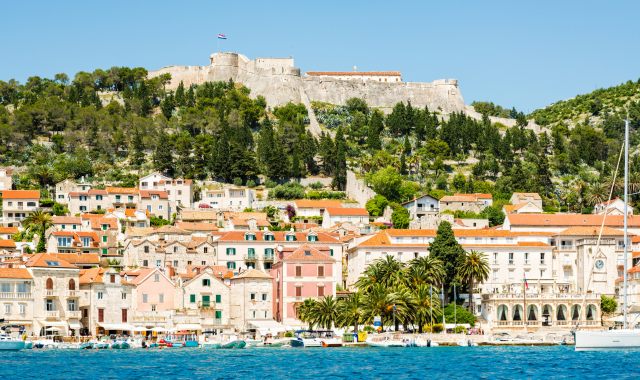
Breathtaking view of Hvar’s town and Spanish Fortress
1. Hvar
Hvar is not only Croatia’s trendiest island, but also the longest and sunniest. Hvar’s Old Town is known for its ancient landmarks, lively beaches and legendary nightlife scene.
What to see in Hvar
Visit its large main square from the Venetian era and wander through the cobblestoned alleys dotted with high-end seafood restaurants, cocktail bars and shops. Stroll along the palm-lined coastal promenade and climb up to the Spanish Fortress for fabulous views of the town and Pakleni Islands.
Beyond the capital, another of Hvar’s trademarks is the lavender fields and vineyards taking over the island’s rural interior. This region is also worth exploring.
How to get to Hvar
Hvar is only accessible by ferry and has 4 ports: Hvar, Stari Grad, Jelsa and Sućuraj. The busiest port is Hvar, which is connected to the Croatian mainland and other islands daily. The starting ticket prices for some of the most popular routes are as follows:
- Split-Hvar: €6
- Dubrovnik-Hvar: €23
- Bol (Brač)-Hvar: €25
- Milna (Brač)-Hvar: €15
- Korčula-Hvar: €6
There also used to be ferry crossings from Makarska to Hvar and Ancona to Stari Grad, however, they are no longer active.
Tip: Check out our dedicated blog to plan the most perfect day trip from Split to Hvar.
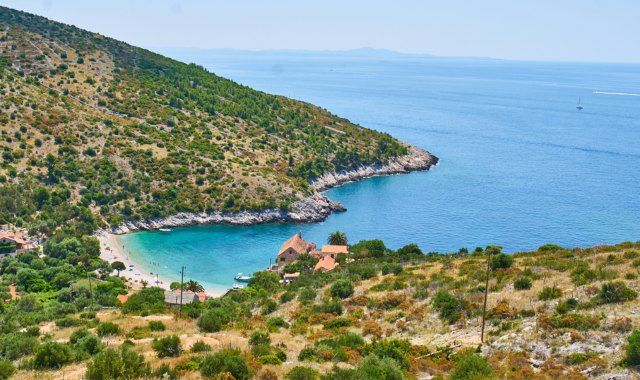
The idyllic Dubovica beach and bay on Hvar Island
2. Brač
Brač, the largest island in central Dalmatia, is mostly famous for its magnificent Zlatni Rat beach (aka Croatia’s most iconic and photographed beach) and its radiant white stone. The island is also one of the most family-friendly destinations in Croatia.
What to see in Brač
Brač’s 2 main centers are Supetar, a lively town with a bar-and-restaurant-lined harbor, and Bol, on the south shore. Behind Bol rises Vidova Gora at 778 m which is the highest peak on the Adriatic islands - climb to the top for astounding views over Bol, Zlatni Rat and Hvar island. The Blaca Monastery, impressively built on the cliffs of Vidova Gora, is also worth checking out.
What to do in Brač
With its great water sports facilities and well-marked hiking and cycling trails, the island attracts a lot of adventure enthusiasts. Brač is also a great place for anyone who wants to unwind and enjoy amazing food and local wine. Just hop on the 50-minute ferry from Split and get ready for your unforgettable vacation!
How to get to Brač
There are 5 ports in Brač with regular connections to the Croatian mainland and nearby islands: Supetar, Sumartin, Bol, Milna, and Sutivan. Some of the ferry connections are seasonal, with ticket prices typically starting from:
- Dubrovnik-Brač: €45
- Split-Bol (Brač): €23
- Split-Milna (Brač): €4.50
- Split-Sutivan (Brač): €4
- Makarska-Sumartin (Brač): €4
Tip: Brač has some of the best beaches in Croatia, such as Zlatni Rat, Murvica and Borak.
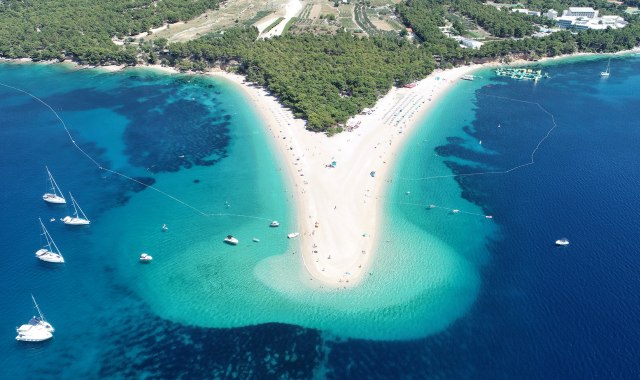
Aerial view of Zlatni rat, one of the most famous symbols of Croatia
3. Korčula
The island of Korčula is a spot that has hardly changed since its most well-known citizen, Marco Polo, set out on his voyages to the East. Korčula’s many treasures hide behind a tiny medieval-walled peninsula.
What to see and do in Korčula
Step through the gates and you’ll find, among others, St Mark’s Gothic-Renaissance Cathedral and several noble palaces. Add to the mix a few quiet coves and white-sand beaches (the best of which is Pupnatska Luka) sandwiched by pine forests and crystal-clear waters, and you have a little slice of paradise.
At dusk, make sure to watch a performance of the moreška sword dance, Korcula's proudest tradition. Then sample the local white, pošip, arguably the best of all Croatian whites.
How to get to Korčula
The main port of Korčula is located on the island's eastern side. There are regular ferry connections with the Croatian mainland and neighboring islands, and prices usually start from:
- Brač-Korčula: €25
- Dubrovnik-Korčula: €10
- Hvar-Korčula: €6
- Split-Korčula: €8.50
In the past, there also used to be a ferry connection from Makarska to Korčula, but it is no longer active.
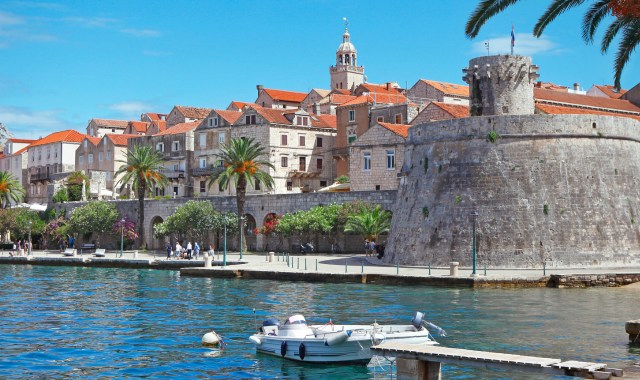
View of Korčula old town and its impressive medieval walls
4. Krk
Joined to the mainland by an impressive bridge, Krk is the largest of Croatia’s islands and draws visitors with its white-sand beaches, pretty fishing villages and lush vineyards.
Highlights in Krk
The island also boasts diverse landscapes, varying from dense forests in the west to mountain-like sceneries in the south, both of which make for a beautiful day’s hike. A few other must’s during a vacation in Krk include visits to the Frankopan Castle in Krk Town, to Vela Luka Bay as well as to the stalactite Biserujka Cave.
Don’t forget to dine at one of the island’s superb kanobes (taverns) serving local specialties such as šurlice (homemade pasta), Krk lamb and the traditional cakes of presnec and povitica. We also recommend heading to Vrbnik, a charming village on the east coast, and sampling Žlahtina white wine.
How to get to Krk
There are many options when it comes to traveling to Krk. Aside from flying to Rijeka Airport, you can reach the island by car or bus via the toll-free Krk Bridge. As for seaborn travel options, there are daily ferry crossings from Cres and Rab to Valbiska on Krk. During the summer months, there are also regular catamaran connections with Rijeka, Rab, Silba and Zadar.
Good to know: Krk is one of the best places to go camping in Croatia, featuring a beachfront campsite with top-notch amenities.
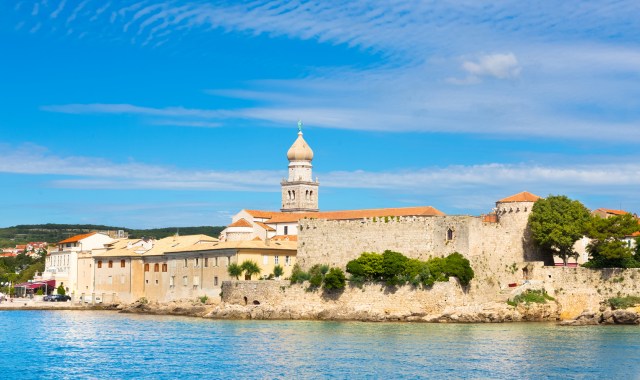
The Frankopan Castle in the old town of Krk
5. Šipan
The largest of the Elafiti Islands, Šipan is one of the best destinations in terms of ancient churches, noblemen’s villas and Roman ruins. The island also boasts some of the yummiest cuisine and best produce in Croatia - with figs and melons being the region's main crops.
Highlights of Šipan
Šipan has 2 main settlements, Šipanska Luka, the largest town on the isle known for the remains of a Roman villa and a 15th-century duke’s palace and Suđurađ, a little harbor bordered with stone buildings and magnificent summer residences and palaces. For the best views on the island, hike or walk to the top of Velji Vrh!
Šipan is an ideal destination for anyone looking to go off-the-beaten-path in Croatia with a delightfully laid-back ambiance.
How to get to Šipan
Šipan is only accessible by ferry from the mainland port of Dubrovnik, as well as the neighboring island of Mljet. If you want to escape the urban life and head to Šipan, board a ferry from Dubrovnik's Gruž port, with the journey lasting about 45 minutes. Alternatively, you can travel from Sobra, Mljet to Šipanska Luka, on the western side of Šipan. This journey takes about 30 minutes.
Ferries travel to Šipan daily, with typical starting prices as follows:
6. Mljet
Mljet is not only Croatia's greenest island, but also among the last paradises in the Mediterranean, according to the World Wide Fund for Nature. Mljet National Park is one of Croatia’s best natural parks and reserves and covers the northern third of the island, featuring 2 stunning interconnected saltwater lakes and surrounded by a lush forest.
What to do in Mljet
Rent a bike and pedal around Veliko Jezero (Big Lake), in the middle of which rises a tiny islet capped by a Benedictine monastery. Alternatively, climb Montokuc, the tallest hill closest to the salt lakes, for an unforgettable panoramic view of Mljet and the nearby isles.
Pomena, the park’s entrance, can be reached from Dubrovnik in around 80 minutes. Check out our blog if you’re interested in planning a day trip from Dubrovnik to Mljet.
How to get to Mljet
There are 3 ports on Mljet, which connect the island to the Croatian mainland and neighboring islands: Pomena, Polače and Sobra. There also used to be a weekly ferry connection from Makarska, but it is no longer active. Some ferry routes are seasonal, operating between April and October, and ticket prices typically start at:
- Brač-Pomena (Mljet): €25
- Dubrovnik-Polače (Mljet): €11
- Dubrovnik-Pomena (Mljet): €20
- Dubrovnik-Sobra (Mljet): €5
- Hvar-Pomena (Mljet): €25
- Korčula-Pomena (Mljet): €18
- Split-Pomena (Mljet): €30
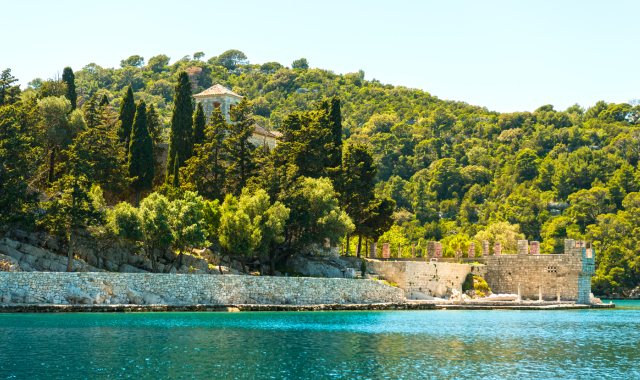
The beautiful salt lake in Mljet Island with the Benedictine monastery, Croatia
7. Lošinj
In the northern Adriatic Sea, Lošinj is divided from the island of Cres by the tiniest of channels and connected by a bridge. It might be smaller but it is the most populated of the twin islands.
What to see and do in Lošinj
Lošinj's natural attractions include the Aromatic Garden, showcasing all the treasure of the island’s most significant scents, and its dolphin population. In fact, its waters are the first protected marine area for the friendly sea mammals in the entire Mediterranean, so keep one eye on the horizon. In addition, the Museum of Apoxyomenos displays an Ancient Greek bronze statue of a young athlete, discovered in 1997.
Lošinj's main town, Mali Lošinj, is the largest on the island and one of the main tourist centers in the Adriatic. It’s ringed by 19th-century villas with gracious gardens, boutique hotels and pine forests.
How to get to Lošinj
Thanks to its location in the Adriatic, Lošinj has direct ferry connections to the Croatian mainland and neighboring islands. In the past there were also ferry connections from Italy, specifically Cesenatico to Lošinj and Trieste to Lošinj, however, they are no longer active. Ferry ticket prices to Lošinj typically start from:
- Pula-Mali Lošinj: €11
- Susak-Mali Lošinj: €4
- Unije-Mali Lošinj: €5
- Zadar-Mali Lošinj: €11
Tip: the Lošinj Aromatic Garden has a store where you can buy homemade jams, herbal teas, natural soaps, and essential oils.
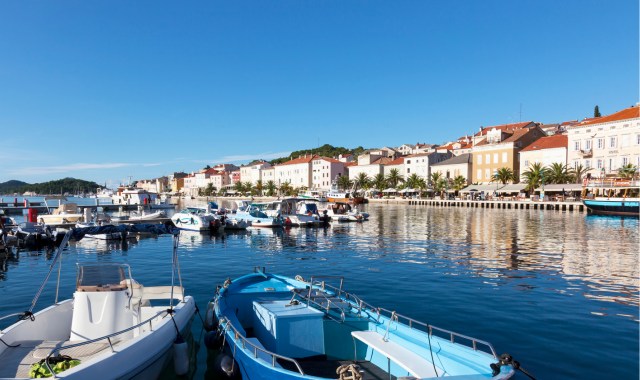
The picturesque town of Mali Lošinj with colorful buildings
8. Lastovo
A small island with a very remote feel, Lastovo is a genuine haven for lovers of sailing, good food and wine, as well as for anyone who doesn’t want to encounter the holidaying masses.
What to see and do in Lastovo
It’s also perfect for nature enthusiasts since it’s part of the Lastovo Islands Nature Park, making it the second most ‘woodiest’ Croatian island (after Mljet). Make sure to visit the main towns of Ubli and Lastovo, the latter of which is famous for its chimneys that were once status symbols of old Lastovo families.
If you decide to stay here overnight, don’t forget to look up at the sky since Lastovo markets itself as ‘the island of bright stars.’ Alternatively, have a look at our dedicated blog to discover our travel tips for the best day trip in Lastovo.
How to get to Lastovo
The only way to reach Lastovo in Dalmatia is by ferry, from either Dubrovnik or Korčula. Starting prices for ferry tickets to Lastovo are as follows:
- Dubrovnik-Lastovo: €11
- Hvar-Lastovo: €6
- Korčula-Lastovo: €7
- Velu Luka (Korčula)-Lastovo: €6
- Split-Lastovo: €8
9. Vis
Croatia's most distant island was cut off from foreign visitors from the 1950s right up until 1989, keeping commercialism at bay. This isolation and lack of development has become Vis’ drawcard as a travel destination. Mostly international travelers now flock to Vis for its picture postcard Mediterranean beauty, its ancient ruins and deserted beaches, as well as its gourmet delights.
Highlights of Vis
After swimming at the crystal clear waters of Milna, Stoncica or Srebrna beach, feast on fresh fish and octopus. Keep in mind that the island’s top restaurants are located in Kut, Vis town. Then try the local vermouth when you stop for an aperitif at one of the cafés on the main street.
How to get to Vis
The only way to travel to the island of Vis is by sea, with the ferry connection from Split and Hvar operating daily, while crossings from the island of Brač are weekly. In the past there also used to be a ferry connection between Makarska and Vis, which is no longer active. Prices for ferry tickets to Vis star from:
- Hvar-Vis: €4
- Split-Vis: €7
- Milna (Brač)-Vis: €6
Fun fact: the movie Mamma Mia! Here We Go Again, which was released in 2018, was filmed on the island.
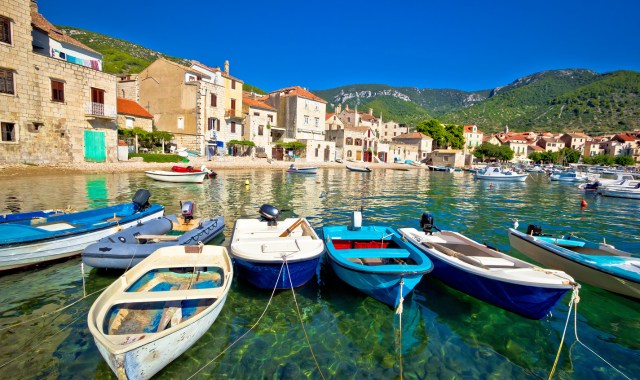
An idyllic beach in Komiza village, Vis island
10. Rab
Rab is the greenest island with the most diverse landscapes in the Kvarner Gulf, leading to its declaration as a geopark in 2008. The more heavily populated southwest coast features pine forests and beaches, while the island’s northeast coast is laced with high cliffs and sandy coves, which are actually rarely found in Croatia. One in particular, Lopar, is ideal for families.
What to see and do in Rab
The enchanting Rab Town is considered by some to be one of the most important historical old towns of Croatia. Bounded by ancient city walls, it is characterized by 4 elegant bell towers rising from the ancient stone streets. Other cultural highlights include the cathedral church of Marija Velika and the Benedictine monastery of St. Andrije. It is also home to plenty of lively bars and restaurants - be sure to try rapska torta, an almond cake unique to the island.
How to get to Rab
There are 3 ports on the island of Rab: Mišnjak in Stinica, Lopar on the northwest of Rab, and in Rab Town. You can visit Rab by catching a ferry from the mainland, as well as the neighboring islands of Krk and Pag. The ferries on the Stinica-Misnjak and Valbiska (Krk)-Lopar routes have car decks, however, the Lun (Pag)-Rab is only for passengers.
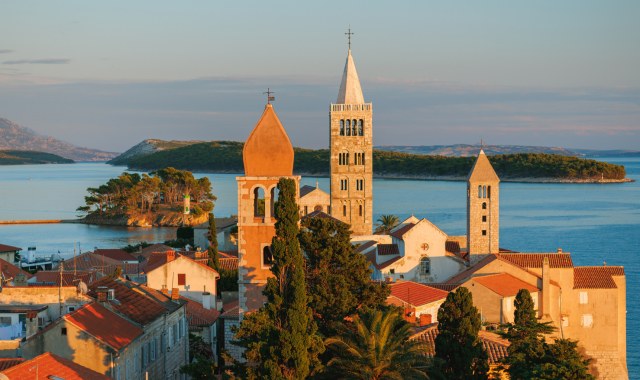
A breathtaking view of Rab island with its iconic church towers
So, now that you’ve read the magic list of the top 10 Croatian islands, which one do you choose? If you can’t pick one, you can also consider going island hopping! Book your ferry tickets at the same price with the ferry companies online on Ferryhopper and get ready for an unforgettable adventure.